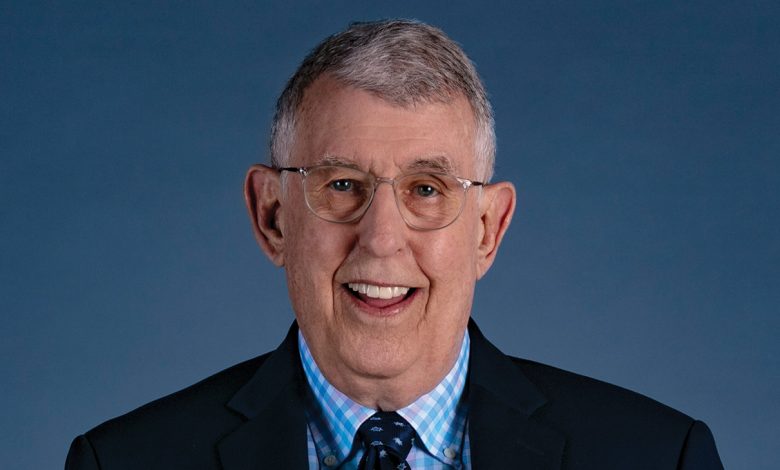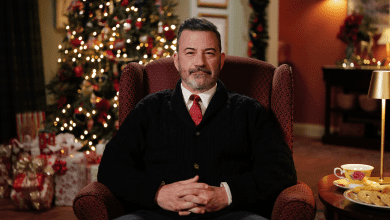The Man Who Changed Live TV Forever

Geoffrey Mason was barely 30, a control-room functionary working a down day at the 1972 Munich Olympics, when history called on a push-button phone.
An unknown number of Israeli athletes had been taken hostage at the Olympic Village, and it was largely up to Mason to decide what to show the world about it. Just the lives of innocents and the future of media hanging in the balance, no biggie.
More than a half century later, Mason is portrayed in September 5, out Nov. 29. Paramount Pictures’ neo-vérité entry into a wide-open Oscar race documents the day when global terrorism, a host country’s angst and media ethics crashed into one another. Workaday actor John Magaro plays him in a career-making turn, a callow producer rising to the spotlighted moment, albeit with no shortage of moral torment and ulcerative stress.
“I cannot begin to tell you how fast events were unfolding in that room,” Mason tells THR. “Every minute brought a new challenge.” The ABC team went full tilt for 1,320 of those minutes, 22 sleepless hours in that cramped space.
In a phone conversation from his home in Naples, Florida, Mason radiates the producorial practical, his matter-of-fact tone underscored by an occasional and charmingly unnecessary “to be quite candid.” Back then, Mason was the kind of person who got excited about camera placement on a mountain to capture just the right shot as a downhill ski racer shushed past. Today, Mason is still the kind of person who gets excited about camera placement on a mountain to capture just the right shot as a downhill ski racer shushes past. He has been around sports broadcasting a long while, 57 years — enough time to produce seven Olympics, a Super Bowl and every other sporting event; to be inducted into the Sports Broadcasting Hall of Fame; and to become tight with Bob Iger.
But he harbors unique reverence for what happened that September day — the convergence of nations and storylines and history. And the shift: In the thousands of years of human civilization before that moment, almost no one had ever had the opportunity to show a calamity in real time. You arrived on the scene after; you read the accounts of the people who were there. This was different. This was a lens onto right now. And Mason would decide where it would point.
“We had no way of knowing the wide range of possibilities we’d face. At least we knew we didn’t have so many live cameras, so if someone got shot, we might not capture it,” he says. But then, he thought, maybe the point was to capture it?
“Can we show someone being shot on live television?” Mason asks in the film, echoing the questions he was asking in real life.
Mason circa the 1972 Munich Olympics. Courtesy of Subject
Mason had been in the Navy; no exercise had prepared him for this. He had raced yachts off the coast of his native Massachusetts and covered the America’s Cup. Those waters were placid compared to this.
Mason worked under ABC Sports legend Roone Arledge that late summer day to deliver live coverage to the U.S. as a masked terrorist from Black September stepped out on the balcony, as the hostages were spirited by helicopter to an airport, as nine athletes and a West German policeman died in a botched rescue attempt, adding to the two members of the Israeli team killed at the time of the attack. Nearly a billion people are believed to have watched some form of coverage in real time around the world — almost a quarter of the global population.
A few years ago, Mason was introduced to a producer named Philipp Trauer and a director named Tim Fehlbaum, two Central Europeans with a wild vision, and found himself sparking to their idea. They wanted to set an entire movie in that control room over the course of one day. Mason unloaded his brain to them, then gave them notes on the script. An “I was really conflicted about this” here; a “we were staring down the barrel of a gun” there. (Literally: Local police showed up, weapons bared, when it seemed as if ABC’s cameras were giving away a sharpshooter’s rooftop position. Mason said, “vielen Dank,” and turned off the camera.)
Many Zoom calls with the filmmakers followed; so did favors called in with broadcasting types to get Magaro and Peter Sarsgaard, who plays Arledge, in to control rooms to see how these rooms worked, to see how people talked in them. And then there was the need for real-life footage of host Jim McKay — ABC didn’t just hand that kind of thing away. Mason picked up the phone and called Iger. A deal was struck.
The MacGyver stunts they pulled that day in September were crazy. If someone put them in a splashy movie, you wouldn’t believe them. They did put them in a splashy movie, and Mason says you should believe them.
“I remember the look on [Howard] Cosell’s face after having tried to get into the [Olympic] Village. He said, ‘Mase, they won’t let me back in.’ I said to someone, ‘Go get an athlete’s uniform and put him in it.’ ” Cosell was 54. He was not an athlete.
Mason kept improvising. They needed to get cameras to the scene. He rolled a couple — giant, heavy, ’70s-esque machines — right out of the control room to train them on Connollystrasse 31, the building where the hostages were being held.
And then, the tragic resolution. Arledge always sat in the control room’s front row and never turned around. Ever. He just heard the chatter through his earpiece and called out instructions.
When it was finally clear the rescue attempt had been botched, the longtime head of Olympics operations, Marv Bader, came up to Mason and said, “Mase, they’re all gone.” All nine hostages, dead.
From the back of the room, Mason spoke the words into Arledge’s earpiece. “He turned around to look at me,” Mason says. “I will never forget the eyes, the look; I remember the exact facial expression. Fear. Anger. Excitement. Exhaustion. You name it. He said, ‘For sure?’ I said, ‘For sure.’
“I’ll never forget that moment, because my view of Arledge went from the back of his head to his eyes looking at me.”
Back at the Sheraton at 2 a.m., now Sept. 6, Mason and others were angry. Really angry. “Angry at the unfairness of it all. It was so antithetical to why we were there. Athletes were deserving of the glory. They didn’t have any glory.”
The emotions soon gave way to sadness. “We are there trying to tell athletes’ heartwarming stories. And suddenly we are bringing this [terrible] news to their families.”
The pain was deep. It still is. It comes to the surface when the actor who plays him asks questions, texting, calling, wanting to know. “He’s someone who still thinks about the events of the day,” Magaro says he soon learned. “It advanced his career, but you can still feel the scars on him. Deep down he’s still coming to terms with the events. How couldn’t you be?”
John Magaro as Geoffrey Mason in Paramount Pictures’ September 5. Courtesy of Paramount Pictures
The pressures of the control room are intense, the releases few. Mason surrendered to alcoholism. He suffered from the disease for two decades, then became sober in his early 40s. He was tired of the juggle, sick of what it was stealing from him. He won Emmys and never remembered being at the ceremony.
Mason started a foundation called Win Back Your Life, with a simple premise: an 800 number you call, and you talk. A sensitive voice is waiting. He connected with Hazelden and the Betty Ford Center, which undergirded his own recovery. He became friends with Betty Ford.
Mason would be there again and again at the intersection of sports and history, a Zelig of the control room. He was there making decisions that July afternoon in 1980 at Wimbledon when Borg and McEnroe chipped and charged for hours. He was there that day in October 1989 when the earth shook under the World Series. But it all comes back to Sept. 5.
Back then, you needed a network insignia and some very big cameras to be a producer. Now you just need a pocket and a phone to pull out of it. Now we are all Geoffrey Mason, every day, wondering what to show, what’s too much, what we can’t live without. If we are unsure of what to do, solace comes from the knowledge that he, too, is often unsure of what to do.
“I am disturbed that journalists go too quickly or with attribution that’s too thin. I get worried they’re moving too fast,” says the media person who, in 1972, moved faster than any media person had moved before.
Mason continues to work, running an independent sports-production company. “Trying to stay relevant. Not busy. Relevant.” To a degree. “I love reading social media, but I’ve never posted anything except happy birthday once to a friend three years ago.” He doesn’t need to post on social media. He helped birth social media.
The hardest part about that day, about covering any standoff, is that no matter which path you choose, it could turn out to be wrong. Show too little, the public doesn’t know. Show too much, tragedy is exploited. But there are lessons; amid the gray, there is one thing that is clear, says Mason. “Make sure the story has integrity. Make sure your perspective gets at the truth. Not just what you think sounds good.”
Mason has these discussions now with his son, who’s spent nearly 30 years at NBC News. They debate how to cover the biggest news stories, now of the 21st century, in a world that moves much faster — how quickly to report, when to hedge their bets. Geoff Mason Jr. lives with the choices his father made — like all of us, navigating the dilemmas of Sept. 5 every day of the year.
Source: Hollywoodreporter
Related Posts
- Roundball Rocked: With NBA Return Looming, NBC Purges Scripted Roster
- SoundCloud Says It “Has Never Used Artist Content to Train AI Models” After Backlash on Terms of Service Change
- Fox News’ Camryn Kinsey Is “Doing Well” After Fainting on Live TV
- Kerry Washington and Jahleel Kamera in 'Shadow Force.'
Courtesy of Lionsgate
…
- This Alternative Artist Landed a Top-20 Chart Debut With an Album Made Almost Entirely on His Phone




